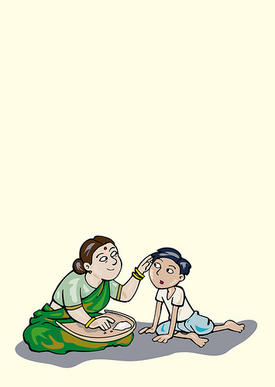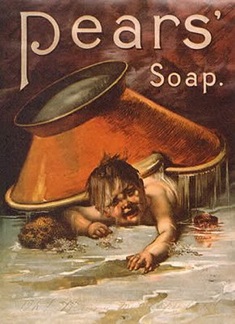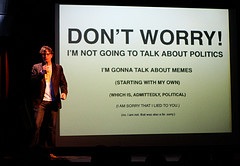The Latest from Boing Boing |  |
- Human Genre Project: short stories and essays about genes and genomics
- CC licensed kids' book art from India
- Google Chrome OS
- Under the Sun: Gordon "Violent Femmes" Gano's jangly and playful new solo album
- Hackers on a Plane: American hackers tour European hackerspaces
- Time-lapse of 1990 LA mall
- Abusive "coal-thugs" try to break up anti-mountaintop-removal festival
- Guerrilla swimming pools made from dumpsters
- iPhone app lets you squash Wall Streeters
- Radiohead manager to launch new record label
- @BBVBOX: recent guest-tweeted web video picks (boingboingvideo.com)
- Hot off the haute couture runway
- Michael Jackson's everlasting death spectacle and "Paedogeddon"
- Bordertown/Borderlands fantasy series to get another volume
- Did you know that Ron Jeremy has a pet tortoise?
- Israeli debate on biometric database melts down when MP starts screaming at blogger for videoing the proceedings
- Documentary about Michael Jackson trufans: "We Are The Children"
- Ignite coming to LA on July 21
- Would you like to be near Michael Jackson's star on the Hollywood Walk of Fame for a mere $90 a day?
- Welcome to the e-wasteland
- Michael Jackson to be buried brainless, coroners say brain must "harden" so tests can be completed.
- Sandia Labs' new SunCatcher power system resembles Magritte painting
- Socialstructing: Bringing Social Back into Our Economy and Organizations
- Fireworks hammers
- Welcome back to the guestblog, Susannah Breslin!
- Creepy vintage print ads
- Flexible "camera" fabric
- Walt Disney and Salvador Dalí's Destino film
- Video: Portal, re-made in ASCII
- North Korea's first beer commercial
| Human Genre Project: short stories and essays about genes and genomics Posted: 08 Jul 2009 02:57 AM PDT SF writer Ken MacLeod and his pals at the ESRC Genomics Policy and Research Forum at the University of Edinburgh have just launched "The Human Genre Project:" The Human Genre Project |
| CC licensed kids' book art from India Posted: 07 Jul 2009 11:33 PM PDT  Maya sez, "Pratham Books is a non-profit trust that publishes high quality books for children at affordable prices and in multiple Indian languages. We have already uploaded some of our books under a CC-license on our Scribd account. We have also started uploading illustrations from our books for people to remix and reuse on our Flickr account. Over the weeks, we will upload more illustrations and add to our existing archive." Maya sez, "Pratham Books is a non-profit trust that publishes high quality books for children at affordable prices and in multiple Indian languages. We have already uploaded some of our books under a CC-license on our Scribd account. We have also started uploading illustrations from our books for people to remix and reuse on our Flickr account. Over the weeks, we will upload more illustrations and add to our existing archive." Pratham Books: Pratham Books - Remixing Illustrations: (Thanks, Maya!) |
| Posted: 07 Jul 2009 10:50 PM PDT Nine months after having launched the Chrome web browser, Google just now announced the Google Chrome Operating System, "an attempt to re-think what operating systems should be." Google plans to offer the OS for use on a wide array of devices in about a year. Snip from the official Google Blog: Google Chrome OS is an open source, lightweight operating system that will initially be targeted at netbooks. Later this year we will open-source its code, and netbooks running Google Chrome OS will be available for consumers in the second half of 2010. Because we're already talking to partners about the project, and we'll soon be working with the open source community, we wanted to share our vision now so everyone understands what we are trying to achieve.Introducing the Google Chrome OS |
| Under the Sun: Gordon "Violent Femmes" Gano's jangly and playful new solo album Posted: 07 Jul 2009 10:36 PM PDT My boyhood chum Paul Simcoe emailed me last week to sing the praises of the new Gordon Gano and the Ryans album Under the Sun. Paul and I grew up together, raised on the Violent Femmes (Gano's earlier band), and now that Paul's running Toronto's most excellent Criminal Records, he's a real treasure-house of kick-ass music suggestions. Though the album isn't due out until Sept 1, Yep Roc, Gano's label, was kind enough to send me the album in MP3 form, and I've been seriously rocking to it ever since. It reminds me most of the Violent Femmes' underrated third album, The Blind Leading the Naked, with its mix of jangly, upbeat pop songs, semi-serious religious themes, and a few slow numbers that are more reminiscent of the track Good Feelings from the Femmes' eponymous debut album. My standouts from this disc are Man in the Sand, Oholah Oholibah, Red, and Wave and Water, whose video was just released on YouTube (see above). I don't usually review stuff far in advance of release date, but Under the Sun was worth jumping the gun for; I've scheduled this post to run again at the beginning of September to remind you that the disc is out. Gordon Gano & The Ryans (Yep Roc) (Thanks, Paul!) |
| Hackers on a Plane: American hackers tour European hackerspaces Posted: 07 Jul 2009 10:08 PM PDT 2600 Magazine's Emmanuel Goldstein sez, Hackers on a Plane: A Brief History (Thanks, Emmanuel!) |
| Posted: 07 Jul 2009 10:04 PM PDT MALL MANIA 1990 time-lapse from Joel Fletcher on Vimeo. Joel sez, "Just posted on Vimeo: A journey back in time to Los Angeles area shopping malls circa 1990." MALL MANIA 1990 time-lapse (Thanks, Joel!) |
| Abusive "coal-thugs" try to break up anti-mountaintop-removal festival Posted: 07 Jul 2009 10:00 PM PDT Apollo sez, "This is a YouTube video of some West Virginia pro-coal thugs (dressed in Massey issued uniforms) crashing the peaceful 23rd annual Mountain Keepers Festival. The festival is a gathering of West Virginians who live in the hollows that are being destroyed by Mountaintop Removal mining, and their fellow advocates from all over the country. At one point the most vile of the thugs threatens a man and his child verbally and with a throat slitting gesture. Simply appalling." Mountain Madness - Invasion of the Coal Thugs (Thanks, Apollo!) |
| Guerrilla swimming pools made from dumpsters Posted: 07 Jul 2009 09:59 PM PDT  Katherine sez, "A group called Macro/Sea is taking used construction dumpsters and lining them to create swimming pools. It's throwing pool parties at undisclosed locations in Brooklyn (I think what they're doing may technically be illegal). One of the people involved is skateboarding legend Jocko Weyland. The current dumpster pools are phase one in a more ambitious plan to reclaim disused strip malls." Dumpster Diving (Thanks, Katherine!) |
| iPhone app lets you squash Wall Streeters Posted: 07 Jul 2009 04:46 PM PDT Susannah Breslin is a guestblogger on Boing Boing. She is a freelance journalist who blogs at Reverse Cowgirl and is at work on a novel set in the adult movie industry.  Squash the $treet is a game for your iPhone that enables you to express your violent dislike of all those smarmy bankers that Americans like to blame for the economic collapse. Squash the $treet is a game for your iPhone that enables you to express your violent dislike of all those smarmy bankers that Americans like to blame for the economic collapse.
Special features include: "Special powerups that boost your squash rate and resentment streak," "Bloody spatter effects," and "Panicked voice-acting and screams by actual bankers." Sounds like fun! Squash the $treet (Thanks, RW!) |
| Radiohead manager to launch new record label Posted: 07 Jul 2009 05:30 PM PDT  (Image courtesy Flickr user Rainsoaked) Brian Message, best known as one of the managers for the best band in the world, is said to be launching a new record label that will allow artists to retain greater ownership of their intellectual property. This article in NME says the new label, Polyphonic, plans to offer artists a 50% base share of profits, with that percentage increasing as an act grows more successful. Reports also indicate that Polyphonic's primary method of distribution will be online. Although specifics details have not been released, the new company's policies look set to place emphasis on the digital distribution of music and may see release plans similar to Radiohead's 2007 album 'In Rainbows', which fans could choose how much to pay for when downloading it. Polyphonic is a joint venture between Message's company ATC and management firms MAMA Group and Nettwerk Music Group, reports the Telegraph.(via PSFK) More in the aforementioned Telegraph article: Radiohead manager teams up with Mama Group to launch record label |
| @BBVBOX: recent guest-tweeted web video picks (boingboingvideo.com) Posted: 07 Jul 2009 04:34 PM PDT  (Ed. Note: We recently gave the Boing Boing Video website a makeover that includes a new, guest-curated microblog: the "BBVBOX." Here, folks whose taste in web video we admire tweet the latest clips they find. I'll be posting periodic roundups here on the motherBoing.)
More @BBVBOX: boingboingvideo.com |
| Hot off the haute couture runway Posted: 07 Jul 2009 04:21 PM PDT Susannah Breslin is a guestblogger on Boing Boing. She is a freelance journalist who blogs at Reverse Cowgirl and is at work on a novel set in the adult movie industry.  One of my favorite fashion blogs is Jak & Jill, which showcases the work of photographer Tommy Ton. The image you see here comes fresh off the Givenchy runway in Paris, where Fashion Week is getting underway. Is this a burqa? What do you call this kind of face jewelry? I don't know, but I love it. (Image credit: Tommy Ton) One of my favorite fashion blogs is Jak & Jill, which showcases the work of photographer Tommy Ton. The image you see here comes fresh off the Givenchy runway in Paris, where Fashion Week is getting underway. Is this a burqa? What do you call this kind of face jewelry? I don't know, but I love it. (Image credit: Tommy Ton) |
| Michael Jackson's everlasting death spectacle and "Paedogeddon" Posted: 07 Jul 2009 04:39 PM PDT  (Image courtesy Tunnelbug) Recovering music industry exec John Niven wrote a hilarious/disturbing piece for the Independent (UK) today on the surreal, ongoing spectacle surrounding Michael Jackson's death, and the willful omission of any mention of those child abuse allegations from most of the coverage. The barrage of utterly inane celebrity tributes ("inspirational", "a true hero", "a genius", "a gentle soul" "a treasure") was to be expected. The howling fans across the world, broken and gibbering nonsense for the rolling TV news crews ("he ... he died for all of us" etc), the inevitable autopsy results in a few weeks, with their Swiss laboratory inventory of prescription tranquilisers, all this too is standard operating procedure.Michael Jackson: Bad! And very dangerous (Independent.co.uk, via @beschizza) Niven is the author of the novel Kill Your Friends. Update: BB commenter "ESCAPINGTHETRUNK" points us to the archive of Maureen Orth's pieces for Vanity Fair on the Jackson molestation charges. And Marc Powell reminds us that the term "Paedogeddon" is a reference to this. |
| Bordertown/Borderlands fantasy series to get another volume Posted: 07 Jul 2009 01:55 PM PDT  Now here's some cool news: Holly Black and Ellen Kushner have sold another volume of stories in the venerable and beloved Bordertown series. This was a series of linked stories and novels about a world in which the Kingdom of the Fairy returns to Earth, connected by a mystical gateway, and about the goings-on in the Bordertown that sits in between the world of humans and the world of magic, a town where technology and sorcery only work intermittently and runaways, rejects, nutcases and heroes gather. It had an incredibly powerful impact on me as a young reader, sparking a lifelong love-affair with contemporary fantasy. I've been invited to write a story, and I leapt at the chance. Other writers committed or "expressing interest" include Charles De Lint, Emma Bull, Will Shetterly, Neil Gaiman and Kelly Link. I don't have the faintest idea what I'm going to write, except that it will probably revolve around a group house or squat. (Image ganked from "The Journal of Mythic Arts") |
| Did you know that Ron Jeremy has a pet tortoise? Posted: 07 Jul 2009 02:02 PM PDT Susannah Breslin is a guestblogger on Boing Boing. She is a freelance journalist who blogs at Reverse Cowgirl and is at work on a novel set in the adult movie industry.  The Independent did one of those things where they ask someone famous a bunch of questions, and this time they asked Ron Jeremy. The Hedgehog. The San Fernando Valley's Hirsute Thespian of Our Times. There's a lot of pressure to perform when you're the best-known [porn] actor in the world; my biggest fear is that I'll be in a scene and I'll suck, and people will say, "Just look at that flaccid noodle." I'm getting older and it feels more of a strain, but I'm still enjoying doing the scenes.Credo: Ron Jeremy, porn star, 56 (Image credit: Robert Yager) |
| Posted: 07 Jul 2009 01:46 PM PDT Jonathan sez, ח"כ מאיר שיט-רית רוצה מאגר ביומטרי אבל מגרש צלם מהדיון (Thanks, Jonathan!) |
| Documentary about Michael Jackson trufans: "We Are The Children" Posted: 07 Jul 2009 01:53 PM PDT  Filmmaker Dianna Dilworth emailed me last week with a link to her documentary about hardcore Michael Jackson fans like the fellow above: We are the Children. "It's a look at the lives of the fans during the trail a few years back," she says -- specifically, trufans out showing support for their idol during the pop star's 2004-05 trial on child molestation charges. As folks who follow me on Twitter already know, I find the cable news MJ-death-marathon spectacle to be a sad reminder of the state of -- well, the pathetic state of American cable news. I mean, what was that? Nine days of wall to wall "Michael Jackson: STILL DEAD"? But thoughtful works like Dilworth's film, works that examine the lives of the "happy mutants" who are utterly devoted to this pop culture figure, I find fascinating. Do yourself a favor today: turn off the TV, stream this instead. You can view Diana's film online for free at SnagFilms, a new ad supported film content site (Flash embed). Or, you can buy a DVD here. |
| Ignite coming to LA on July 21 Posted: 07 Jul 2009 01:33 PM PDT Brady Forrest says: This will be the first Ignite in Los Angeles; it is co-hosted by LA Geek Dinner. Doors are open at 6:30 for Geek Dinner. The Ignite talks will run from 8:00-9:30. Please RSVP to the Geek Dinner list on Upcoming. If you're working on an interesting project, have an unusual skill, or just some interest that would be fun to share with everyone, please submit a proposal to: http://bit.ly/IgniteLA Ignite LA is being organized by Brady Forrest, Matt Forrest, Dan Gould, and Heathervescent. It is a free event. If you're not familiar with Ignite check out some videos on the Ignite Show. |
| Would you like to be near Michael Jackson's star on the Hollywood Walk of Fame for a mere $90 a day? Posted: 07 Jul 2009 01:51 PM PDT Susannah Breslin is a guestblogger on Boing Boing. She is a freelance journalist who blogs at Reverse Cowgirl and is at work on a novel set in the adult movie industry. Just because you didn't make it to today's moving tribute to everyone's favoritest King of Pop, it doesn't mean you can't comfort yourself by living as close as, well, you can to his star on the Walk of Fame. Sure, it's a sad consolation prize, but it's something ... Isn't it? Thanks to Craigslist, you can rent a one-bedroom MJ "memorial," uh, suite for dollars a day: "$90 / 1br - Michael Jackson memorial - 1 bedroom apt in Hollywood." "Walk to Michael's Star on Hollywood Blvd. just a few blocks away," the landlord touts. I say go for it. |
| Posted: 07 Jul 2009 01:09 PM PDT Susannah Breslin is a guestblogger on Boing Boing. She is a freelance journalist who blogs at Reverse Cowgirl and is at work on a novel set in the adult movie industry.  London-based photographer Sophie Gerrard has created a photo series called "E-wasteland," a graphic look at the toxic effects of electronic waste on India's land and its people. Every year, Gerrard writes, 20 to 50 million tons of electronic waste are generated worldwide. India has become one of the world's largest dumping grounds for e-waste. E-waste is highly toxic. It contains lead, cadmium, mercury, tin, gold, copper, PVC and brominated, chlorinated and phosphorus based flame retardants. Many of these heavy metals and contaminants are extremely harmful to humans as well as to animals and plants.E-wasteland: The growing problem of e-waste in India (via riley dog) |
| Michael Jackson to be buried brainless, coroners say brain must "harden" so tests can be completed. Posted: 07 Jul 2009 05:13 PM PDT Pop star Michael Jackson will be laid to rest today in a Los Angeles cemetary without his brain. Doctors investigating the cause of his death are retaining it for an undetermined period of time so they can perform further tests. Michael Jackson to be buried without his brain (Guardian UK, via @laughingsquid / Image courtesy Flickr user El_Enigma) |
| Sandia Labs' new SunCatcher power system resembles Magritte painting Posted: 07 Jul 2009 12:45 PM PDT  The news release from Sandia National Laboratories says the SunCatcher power system (above) unveiled at the National Solar Thermal Test Facility today is the result of a design partnership with Stirling Energy Systems and Tessera Solar. But I think they really designed 'em with Belgian surrealist painter René Magritte. Yes, I know he died in 1967, but the gubmint's secret art-zombie time travel machines address that matter. Duh. |
| Socialstructing: Bringing Social Back into Our Economy and Organizations Posted: 07 Jul 2009 01:32 PM PDT Guestblogger Marina Gorbis is executive director at Institute for the Future. My mother knew well the value of social capital, although she probably never heard the term. In the Soviet Union where she lived and where I grew up one couldn't survive without it. She traded social capital on a daily basis. It meant that despite being a widow with very little money, despite not having a high position or a membership in the "privileged" class (the Communist Party), she was able to provide a relatively good life for her family. We never worried about having enough food, my sister and I always wore fashionable (by Soviet standards, at least) clothes, took music and dance classes, went to good schools, spent summers by the seashore, went to the symphony, and otherwise took advantage of a lifestyle that seemed much beyond our means. How was my mother able to provide all these things? She certainly couldn't afford them on her pitiful wages as a physician in a government-run clinic in Odessa, Ukraine. Social capital--networks of relationships with friends and acquaintances -- is what accounted for her ability to provide for a relatively comfortable, albeit not luxurious, lifestyle. While there was no meat to be found in any store in the city, my mother got it regularly (along with other provisions) through the director of a supermarket, who was also a husband of a close colleague. I got into music school in exchange for my mother treating the director of the school. We could get Western medicines because my mother was friendly with the head of a large local pharmacy. Our apartment was always filled with people who my mother was counseling, diagnosing, treating, and prescribing medicines for. No money was ever exchanged. Ever mindful of Stalin's purges and his fabricated case against Jewish doctors' alleged conspiracy to poison Soviet leadership, she was too afraid to have an underground private medical practice or take money for her services. "With my luck, I would be the first to be caught," she always said. The people who could be regularly found in our home or whose homes she visited dispensing medical services were her substitutes for money. They and many other "connections" she built over a lifetime were her doors to resources -- from tangible commodities such as food, medicines, and clothes, to information, services, and emotional support. Our story was not unique. All around us, amid empty stores, low salaries, dismal productivity numbers, and fraying infrastructure, people seemed to live normal "middle class" lives. An economist would have a hard time explaining how this was possible by looking at economic statistics or by walking around the stores and markets in Russia in the 1960's and 70's. Visitors to the Soviet Union, in fact, were always amazed at the gap between what they saw in state stores--shelves empty or filled with things no one wanted--and what they saw in people's homes--nice furnishings and tables filled with food. What bridged the gap was the informal economy, an economy driven by social rather than financial capital. This economy was deeply rooted in the myriad relationships people like my mother used to acquire goods, services, information, education, and many other things. They did not do this consciously--no one was teaching them how to grow their network or increase their following the way many social marketers are eager to teach us today, they just did this to survive. The web of social relationships was an invisible fabric that permeated the economic life and made that particular society work. Social capital has served a critical role in the economic life of the Soviet Union and continues to do so in many poorer countries today. Teodor Shanin, an eminent sociologist, has invented a field of study called "peasantology," which looks at how people survive in informal economies. Shanin argues that peasants inhabit an economic structure entirely different from either capitalism or socialism. The key element of the peasant economic structure is the existence of dense and vibrant social and family networks that provide members access to necessary resources. Researchers observed the phenomenon first in Africa years ago where they could not find any economic explanation for how the majority of the population survived. They didn't own land. They didn't seem to have any assets. Marxist and market economists had always dismissed such activity as marginal. However, as Shanin argues, one is hard pressed to see something as marginal when half of mankind lives like this. In fact, social capital also plays an important role in developed economies, as many researchers such as Manuel Castells and Robert Putnam, among others, have shown. However, far too often we have pushed social capital and notions of non-monetary currencies out of our economic thinking and economic interactions. One can in fact view the whole history of economic development as a long path of taking local, familiar, personal, and social out of economic relationships and replacing them with professional, impersonal, and highly institutionalized economic interactions centered on exchanging one form of capital--money. It is hard to argue that this has brought great efficiency to our economic life and has resulted in spectacular growth rates in societies that have followed the path. In the process, we have built organizations and regulatory frameworks that allowed us to scale what previously were familiar, often familial, economic relationships to include anonymous strangers, thus allowing for aggregation of resources across geographies and social boundaries. Organizations we created and that dominate our economic landscape today, with a limited liability corporation as its crowning glory, have been great innovations in their time and enablers of much of our prosperity. They massively increased the scale of economic interactions and at the same time became institutional proxies for the kind of trust we previously reserved for our neighbors and family. We have become successful at the art of operating at scales massively beyond the local village and beyond the boundaries of social relations. We know how to organize people and resources for the ultimate goal of maximizing monetary returns. Along the way, we developed a host of management theories and practices that have become bibles to generations of working men and women. And the corporate culture we created spread well beyond the business realm. As Doug Rushkoff points out in "Life Inc.," corporatism or corporate way of thinking has permeated our culture, language, philanthropic organizations, schools, and media. It is how we've come to think about getting things done. We almost cannot conceive of a world without hierarchical organizational charts, mission statements, departments, and clear sets of corporate rules and incentives. All of this is about to change. Computing and communications technologies are not only linking us into a one global village, one global brain, they are also adding a new layer of sociality to our interactions and are making it possible for us to engage in new kinds of transactions with each other outside of existing organizational boundaries. They are making it possible for us to gain access and build trust that we previously outsourced to organizations. They are also taking anonymity out of many economic transactions. We can gain new levels of knowledge about strangers by following their Twitter streams, looking up their friends on Facebook, checking their reputations as buyers and sellers on E-Bay, measuring their contributions to Wikipedia, watching their Youtube videos. We can lend our money directly to people and projects we find appealing on Kiva.org rather than entrust the money to banks to invest anonymously and without any say from us. Even public relations is changing from relying on official public releases to increasingly whispering to the right people in one's social network (as an example see this recent article in the NYT). We are bringing a whole new level of sociality, familiarity, and connectedness to our economic interactions. In a word, we are socialstructing our organizations, i.e. reorganizing them around social connections rather than against them. But social connections we organize around are different from face-to-face relationships our ancestors grew up with. We are witnessing a rise in what I call information-driven sociality -- sociality that derives from our ability to get direct access to strangers and remove their anonymity by giving us access to information trails they leave behind, thus providing us with knowledge about many aspects of their selves--interests, reputations, online contributions, musical tastes, even buying preferences. In the process, the raison d'etre for many types of organizations we created over the past few centuries -- organizations needed for aggregating resources and enabling transactions between anonymous strangers -- is disappearing. Amplified with the collective intelligence, access, and resources embedded in social connections with multitudes of others, we are now increasingly able to achieve the kind of scale and reach previously achievable only by large organizations. Driven by information-driven sociality, the next decade will usher in a whole new array of organizational models, new forms of currencies, and new sets of work practices. At the same time we will need to create new regulatory frameworks suited for organizational forms based on principles of social connectivity and familiarity. Remember the old adage of "Keep social out, don't bring it into the workplace?" The new adage is "Social is business, bring it in." |
| Posted: 07 Jul 2009 11:37 AM PDT |
| Welcome back to the guestblog, Susannah Breslin! Posted: 07 Jul 2009 11:40 AM PDT  I am delighted to welcome back a returning Boing Boing guestblogger: author, photographer, and blogger Susannah Breslin. She has written for Details, Newsweek, Harper's Bazaar, The Daily Beast, Radar Online, Variety, Salon, Wired News, The New York Post, The LA Weekly, The San Francisco Chronicle, The Vancouver Sun, The San Francisco Examiner Playboy.com, Nerve, Arena (UK), and Max (France). She has appeared on CNN, FOX, Playboy TV, "Politically Incorrect," UK Channel 4, and NPR. She is writing a novel that's set in the adult movie industry. She is beautiful, as you can see from the above photo; she is talented, as you will see from the posts to follow; and she is rather tall: 6'1". |
| Posted: 07 Jul 2009 10:42 AM PDT    RetroComedy posted their picks for "15 Creepiest Vintage Ads of All Time." Above are my faves from the bunch. (Thanks, David Steinberg!) |
| Posted: 07 Jul 2009 10:14 AM PDT  MIT researchers developed light-detecting fibers that could eventually be woven into a "fabric camera." Instead of counting on a single lens, the new system would use a web of the fibers as a distributed imaging surface. Imagine a shirt where the entire back is a "camera." From MIT News: The researchers, led by Associate Professor Yoel Fink of the Department of Materials Science and Engineering (DMSE), emphasize that while such an application and others like it are still only dreams, work is rapidly progressing on developing fabrics capable of capturing images. In a recent issue of the journal Nanoletters, the team reported what it called a "significant" advance: using such a fiber web to take a rudimentary picture of a smiley face."'Flexible camera' replaces lens with fiber web" |
| Walt Disney and Salvador Dalí's Destino film Posted: 07 Jul 2009 10:00 AM PDT Here is Destino, the collaboration between Walt Disney and Salvador Dalí. Production began in 1945 and the film didn't premier until 2003. Apparently, it will finally see an official home DVD release in 2010 along with a documentary about the two artists' history together. Destino (Wikipedia) (Thanks, Kirsten Anderson!) Previously: |
| Video: Portal, re-made in ASCII Posted: 07 Jul 2009 09:44 AM PDT  Over at Offworld, we've just dug up what'll probably be the most mind-bending video of the week: the first look at Joe Larson's 'demake' of Valve's PC/Xbox 360 hit Portal, rendered entirely in ASCII. Its best trick that puts it a leg up on the 2D Flash version: a 'through the portal' view that recaptures everything that made the original game so awe inspiring to experience for the first time (also: its simple 1-character companion cube, and the Donkey Kong tribute toward the end of the video). Watch the video on Offworld. Over at Offworld, we've just dug up what'll probably be the most mind-bending video of the week: the first look at Joe Larson's 'demake' of Valve's PC/Xbox 360 hit Portal, rendered entirely in ASCII. Its best trick that puts it a leg up on the 2D Flash version: a 'through the portal' view that recaptures everything that made the original game so awe inspiring to experience for the first time (also: its simple 1-character companion cube, and the Donkey Kong tribute toward the end of the video). Watch the video on Offworld. |
| North Korea's first beer commercial Posted: 07 Jul 2009 08:46 AM PDT The first TV commercial in North Korean history is now on the air. It's an ad for a Taedonggang beer described as the "Pride of Pyongyang" and the ad promises that beer will reduce your stress. North Korea launches beer advert (via MeFi!) Previously:
|
| You are subscribed to email updates from Boing Boing To stop receiving these emails, you may unsubscribe now. | Email delivery powered by Google |
| Google Inc., 20 West Kinzie, Chicago IL USA 60610 | |






No comments:
Post a Comment